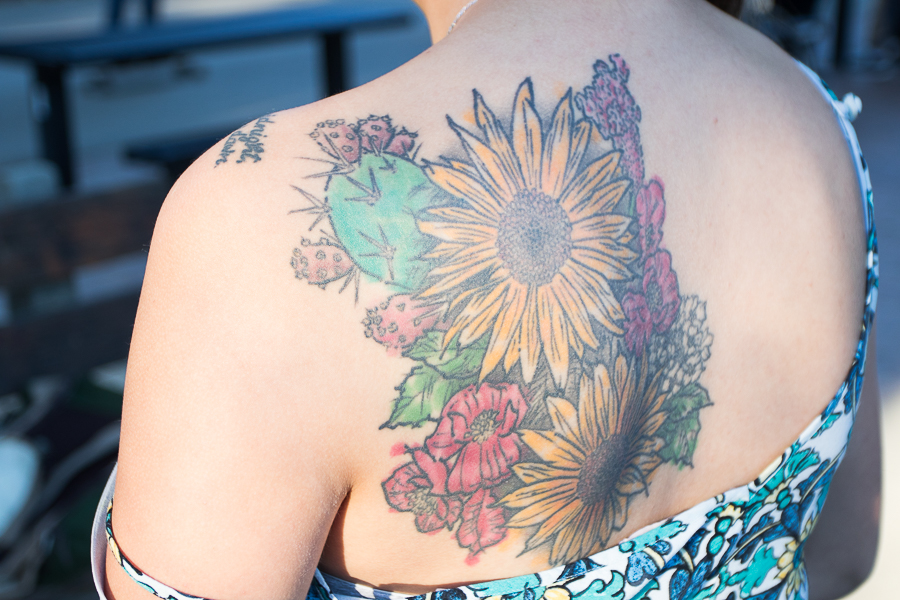
How technology has found its way into the tattoo industry
The image of a tattoo artist hunched over a light table with pencil smudges covering the side of the artist’s hand may not be as true as it was before. For many, a pencil has been replaced by a stylus, a light table and paper by an iPad. Indeed, technology has integrated itself into the tattoo industry, changing the way that artists design their tattoos, as many tattoo artists have transitioned to using applications such as Procreate to design their tattoos on an iPad.
“Procreate basically has everything you could do with paper and pencil,” said Phil Geck, a tattoo artist at Davis tattoo parlor Death or Glory. “It has the same process as if you were designing on pen or paper, but all in one easy application.”
With its various functions, this tool can create the same effects that one could produce with the old-school design method.
“You can use a colored pencil on it, you can add layers to it and go over it with a pen tool and have that in a seperate layer,” Geck said. “I think people are able to do a lot more and get more intricate with it since there a lot more tools in here and different effects. Say you wanted to play with light sources — there’s an airbrushing tool.”
For Jonathan Martinez, another tattoo artist at Death or Glory, the application also makes it easier to reference drawing form the internet, having it side-by-side with what he’s drawing.
However, the application not only copies the old-fashioned tattoo design process, but also improves upon it.
“From this app, I can transfer it directly to the copy machine and print out how many sizes of it I want on the paper,” Geck said, “instead of having to draw it and then trace that again on tracing paper and then sending it to the copy machine and sizing it a few times and then going over it and stenciling it. You can also take a picture of someone’s arm, for example, if they want to get the tattoo on their arm and import that image from your phone onto the app and draw on the arm so that they can see what it looks like.”
With these types of improvements, the integration of this app has allowed for greater efficiency.
“It’s really changed productivity and cut down my drawing time by at least 50 percent,” Martinez said.
It also allows for the artist to be more mobile in the designing process, not limiting them to the tools only available in a tattoo parlor.
“If I want to draw on the run or do it in a public space, I don’t have to haul a drawing board or a bunch of paper,” Martinez said. “Sometimes I used to have to get here to draw, and now it’s with you all the time. I like to draw in bed, and there’s no mess when I’m drawing on my iPad.”
Another benefit of this technological transition has also been the limited environmental waste.
“I used to carry in my backpack that I would carry my light table, big thing of tracing paper which has a huge cardboard backing, tape and regular paper and pens and pens — tons of stuff,” Geck said. “Now everything I use now is rechargeable. We didn’t realize how many materials we were using until we stopped; that’s a huge plus.”
For Geck, “ego” might get in the way of some artists choosing not to use such new technology.
“I like to adapt to my surroundings and also my time is very valuable, so if this can save me time and help me in the process of being creative I’m for it,” Geck said.
Whether or not a tattoo artist uses technology in design depends on personal preference, according to Jake Stebbins, a third-year computer engineering major who has a tattoo.
“More hardcore artists may feel more confident designing something from scratch on a more classical medium like paper and might see using technology is cheating,” Stebbins said. “I think that using technology is a totally viable option, especially if the artist designed them on their own. To me it’s just another medium like canvas or paper; I don’t think technology inherently just removes the human element.”
However, there are some limitations to using applications like Procreate, since they lack the human feel that is necessary for some designs.
“The feel is one drawback; you can’t feel the graphite to the paper,” Martinez said. “You can’t feel the friction. When I do a lot of script, I have to still do it on paper rather than the app. While the app can mimic it pretty closely, script is more a hand-control style thing that the iPad is too sensitive for.”
For Stebbins, the designing method of tattoos is not necessarily the deciding factor in deciding his tattoo artist.
“I would be somewhat indifferent to the use of technology by a tattoo artist,” Stebbins said. “If the artist feels more comfortable doing it that way, it’s fine by me. I just would want them to be the one that makes it, not a program or design found somewhere else, unless it’s the exact one that I want.”
Whether a tattoo is designed on paper or on a screen brings up the question of how and in what sectors technology has embedded itself in society. Tattoo artistry seems to be the next realm.
“It’s the classic question of digital vs. analog: both have their pros and cons but at the end of the day it comes down to how you want to design it to get the output you want,” Stebbins said.
Written by: Caroline Rutten — arts@theaggie.org



